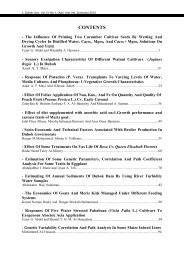You also want an ePaper? Increase the reach of your titles
YUMPU automatically turns print PDFs into web optimized ePapers that Google loves.
J. Duhok Univ., Vol.14, No.1 (Pure and Eng. Scienes), Pp 17-24, 2011<br />
RESULTS & DISCUSSION<br />
Figure 1 shows a typical AFLP gel image for<br />
the 21 varieties studied with the primer<br />
combinations (P101/M181) and (P101/M184). In<br />
this study genetic fingerprinting, phylogenetic<br />
diversity and genetic distance of peach varieties<br />
from Kurdistan region was evaluated by using<br />
AFLP markers. There were some studies had<br />
been done to estimate diversity of peach<br />
cultivars in Lebanon using microsattalite primer,<br />
(Chalak et al., 2006), AFLP markers also used to<br />
evaluate genetic diversity of ornamental peaches,<br />
(Donglin et al., 2005). Table 4 summarize the<br />
values of genetic distance of 21 peach varieties<br />
from different sources and locations.<br />
The genetic distance values ranged from<br />
(0.0073 to 0.8572). It was clear that the lowest<br />
genetic distance (0.0073) was found between<br />
varieties (Tenee) and (Esmailly) which were<br />
collected from Erbil, whereas the highest genetic<br />
distance (0.8572) was found between varieties<br />
Badree) and (Elberta) were collected from<br />
Duhok and Sulaymani respectively means that<br />
the similarity between them is very low.<br />
The dendrogram based on UPGMA produced<br />
three major clusters as shown in (Figure 2). The<br />
first genetic cluster mostly consisted of (Korneet<br />
Asfer, Floredasin, Motaem Bkornet Mobaker<br />
(Ahmer), Sprink Time, Nectar 4, Nectar 6,<br />
Ahmer Myse, Badree, Mskee, Tenee, Esmailly,<br />
Migrant, Abo-zalma, Silverking). The second<br />
genetic cluster consist of (Read Heaven, Sharly<br />
Shapor). While the third genetic cluster consists<br />
of (Zard, Elberta, Zaefaran, Dixired, J. H. Hale).<br />
The total number of amplified DNA fragments<br />
may make these varieties comes in separated<br />
groups. Studying the morphology of these<br />
varieties, it is noted that they have some<br />
characters that are close to each other, for<br />
example, the shape and color of fruits. Subclusters<br />
separated the varieties and form distinct<br />
genetic diversity among clusters.<br />
The genetic relationship among the cultivars<br />
based on molecular marker analysis will be<br />
useful for varietal identification and in further<br />
genetic improvement. It will also provide<br />
support for selection of parents for crossing in<br />
order to broaden the genetic base of the breeding<br />
programs (Thorman and Osborn, 1992).<br />
Estimation of genetic relationships will help to<br />
prevent genetic erosion within varieties by<br />
selecting a large number of different clones of<br />
each variety (Rühl, et al., 2000). Results of this<br />
study will provide guidance for future<br />
germplasm collection, conservation and breeding<br />
of peach.<br />
Table (1): Primer name and their sequences used for AFLP analysis<br />
No. Pre selective primer (‘5------3’) Selective primer (‘5-----3’)<br />
1 POO GACTGCGTACATGCAG P101 GACTGCGTACATGCAGAACG<br />
2 M43 GATGAGTCCTGAGTAAATA M181 GATGAGTCCTGAGTAACCCC<br />
3 M184 GATGAGTCCTGAGTAACCGA<br />
Table (2): Name and sampling region of the peach varieties used<br />
No. Name of Varieties Location Number of<br />
1. Korneet Asfer, Floredasin, Motaem Bkornet mobaker (ahmer), Sprink time,<br />
Nectar 4, Nectar 6, Ahmer myse, Badree<br />
Varieties<br />
Duhok 8<br />
2. Mskee, tenee, Esmailly, Migrant, Abo-zalma, Silverking Erbil 6<br />
3. Read heaven, Sharly shapor, Zard, Elberta, Zaefaran, Dixired, J. H. hale Sulaymani 7<br />
Total 21<br />
Table (3): Total number of bands, number of polymorphic bands and their<br />
percentage as amplified by the two primer combinations.<br />
AFLP primer Combination Number of Amplified<br />
Bands<br />
Number of<br />
Polymorphic Bands<br />
Percentage of Polymorphic<br />
Bands<br />
P101/M181 57 49 85.9%<br />
P101/M184 67 60 89.5%<br />
Total 124 109 87.9%<br />
19



